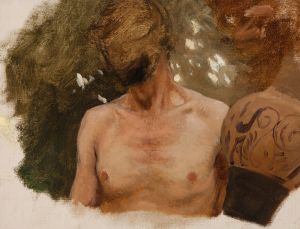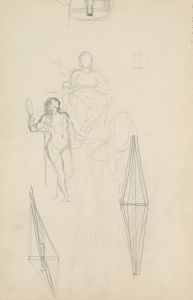
szkic do kompozycji przedstawiającej apoteozę króla Jana III Sobieskiego
A hand-painted replica of Henryk Siemiradzki’s masterpiece szkic do kompozycji przedstawiającej apoteozę króla Jana III Sobieskiego, meticulously crafted by professional artists to capture the true essence of the original. Each piece is created with museum-quality canvas and rare mineral pigments, carefully painted by experienced artists with delicate brushstrokes and rich, layered colors to perfectly recreate the texture of the original artwork. Unlike machine-printed reproductions, this hand-painted version brings the painting to life, infused with the artist’s emotions and skill in every stroke. Whether for personal collection or home decoration, it instantly elevates the artistic atmosphere of any space.
Henryk Siemiradzki was a renowned Polish painter of the 19th century, celebrated for his large-scale historical and mythological scenes. One of his notable works is the "Szkic do kompozycji przedstawiającej apoteozę króla Jana III Sobieskiego," which translates to "Sketch for the Composition Depicting the Apotheosis of King John III Sobieski." This piece is a preparatory sketch for a larger composition that Siemiradzki intended to create, focusing on the glorification of King John III Sobieski, a significant figure in Polish history.
John III Sobieski was the King of Poland and Grand Duke of Lithuania from 1674 until his death in 1696. He is best known for his military prowess, particularly his victory at the Battle of Vienna in 1683, where he played a crucial role in defeating the Ottoman Empire's forces. This victory was pivotal in halting the Ottoman advance into Europe and earned Sobieski the reputation of a hero in Christendom.
Siemiradzki's sketch likely aimed to capture the grandeur and historical significance of Sobieski's achievements. The concept of an "apotheosis" in art refers to the elevation of someone to divine status, often depicted through grand and symbolic imagery. In this context, the apotheosis of Sobieski would involve portraying him in a manner that emphasizes his heroism and contributions to European history, possibly surrounded by allegorical figures or symbols of victory and peace.
Siemiradzki's style is characterized by its attention to detail, vibrant use of color, and dramatic compositions, often drawing inspiration from classical antiquity and the Renaissance. His works frequently feature elaborate settings and a keen sense of theatricality, which would have been well-suited to a subject like the apotheosis of a national hero.
While the specific details of this sketch are not extensively documented, it can be inferred that Siemiradzki intended to create a work that not only celebrated Sobieski's military achievements but also his legacy as a unifying figure in Polish history. The sketch would have served as a preliminary exploration of composition, form, and thematic elements, guiding the artist in the creation of a more detailed and finished piece.
Siemiradzki's contributions to art were significant during his lifetime, and his works continue to be appreciated for their historical and cultural value. His ability to blend historical narrative with artistic expression made him a prominent figure in the art world of his time, and his depictions of Polish history remain influential.
In summary, the "Szkic do kompozycji przedstawiającej apoteozę króla Jana III Sobieskiego" by Henryk Siemiradzki represents an artistic endeavor to honor and immortalize one of Poland's most celebrated historical figures through the medium of painting. The sketch serves as a testament to Siemiradzki's skill in capturing the essence of historical grandeur and his dedication to portraying the rich tapestry of Polish heritage.


















